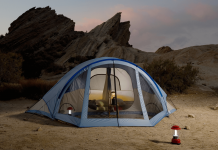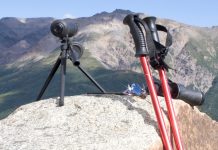The wind can be a great disaster when camping. To avoid getting your tent blown away, you will need to improvise ways to secure it. Not all tents can withstand the high winds. Sometimes the winds come without warning. Having a secure tent outdoors will keep you safe and comfortable. Bad weather is not suitable, especially if you are out with kids. You, therefore, need to keep the tent as stable as possible. Below are ways on how to secure a tent in high winds.
Have The Right Tent
Some tents are exclusively designed to withstand high winds. The right tent designed for high winds will stay secured once set up. Also, ensure the material of the tent is wind-resistant. It may be costly but worth it. It will save you a lot of money and stress at the end of the day.
Set Up The Tent Correctly
To ensure your tent stays strong even on strong winds, it needs to get secured from the start. When setting up the tent, location is vital. Setting a tent in an area prone to strong winds can be very tricky.
Find the right spot when setting up the tent. To make it more secure, place it next to a natural windbreak, near rocks or the woods.
If there are small rocks nearby, you can use them to secure the tent. In the selected area, if it is near a tree, you should ensure the branches of the tree are not affected by the strong winds. Otherwise, you will have them falling on top of your tent, making it prone to breakage. Avoid setting up the tent when it is windy. Wait until it’s calm, and that’s when securing it will be a lot easier.

Face The Tent Away From The Wind’s Direction
For the tent to maneuver high winds, ensure the tent’s opening doesn’t face the direction of the wind. It helps keep the tent secure than when you let it face the wind directly.
step:1 Put A Tarp
A tarp gives additional support to the tent to secure it from the high winds. It is something you do not want to miss carrying along in your camping trip. They not only add additional support but also protects against weather elements such as rain or wind. You can place the tarp underneath the tent. Please do this before setting up the tent and then cradle it with the tap after pitching it. Tarp can also be on the inside of the tent.
A tarp needs to get placed over the tent to protect it from the wind. Tarps are available as either square or rectangular, and the tighter it is, the more stable it will be. When pitching a tarp, you can decide to set it low or high depending on your tent and the wind’s strength. Ensure the knots are tight to not come out with the wind. Place it on top of the tent and secure it with poles and ropes.
step:2Add More Weight
The more weight the tent has, the more stable it gets. When you go camping, you need to carry along essential gear needed for the whole trip. In these gears, there are some which are heavy while some are lightweight. You should arrange the tent’s gears so that the heaviest gets suited at the corners of the tent. High winds won’t sweep away a tent secured with heavy pillars. So place all your heavy equipment on the corners of the inside tent to make it more stable.
step:3 Extra Guy Ropes/Peg Points
Sometimes the poles and ropes used in pitching the tent might not be enough to keep it secure from high winds. You will need more ropes to make it more stable. Ensure you use all the peg points in the tent, and they are well set. The peg points should be at an angle of 45 degrees and adequately inserted into the ground away from the tent. Also, the ropes shouldn’t be too close to the tent if you want a stable tent. Have extra strings and peg points placed in different directions.

step:4Guy Line
It is a string used in place of a pole that holds down a tent or even a tarp. It provides stability to the tent to combat the high winds from blowing off your tent. When added to the tent or tap, you end up with a more stable tent outdoors. It helps the tent to stand firm against wind or any weather. You will be required to attach them o the guy loops on the tent or the tarp and make a knot and anchor it.
step:5Awnings
Some tents will have what we call verandahs or awnings. The awnings are usually collapsible, and if not, try and peg them down. Doing so prevents wind from getting inside them, making them a little secure from the high wind.
step:6Sleep As A Group
When you sleep more than one person in a tent, the tent will have added weight. More weight won’t make the tent fly away when there are strong winds outside. So, when camping as groups, instead of everyone having his or her tent, why not share the available tent? Sleeping together does not only protect the tent from the winds but also a great experience not getting lonely on an outdoor adventure.
High winds are unpredictable most times. Before camping, always check the weather forecast to help you prepare for any bad incidences. Knowing how well to secure a tent can help work out things for you if the tent you are using does not withstand high winds. When you start planning for an outdoor trip, take the necessary gear for emergencies, emergencies such as strong winds, heavy rains, and earthquakes. Also, find a secure location with a natural windbreak to minimize the hustle of setting up additional windbreaks. If the winds are too strong for the tent, it is always better to pack and either go home or find another location.
































